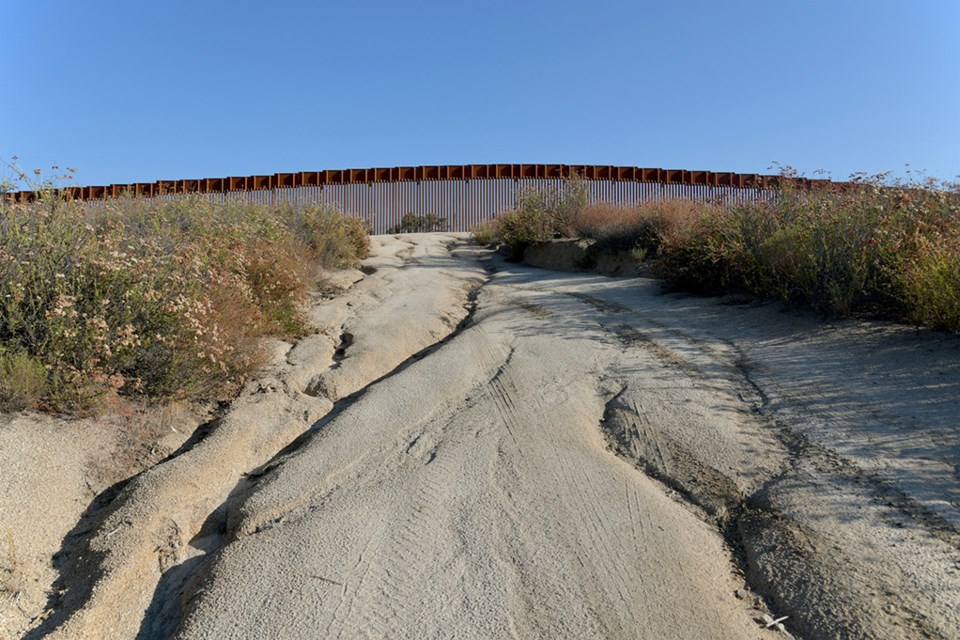In late May 2024, I travelled to the United States-Mexico border to study the smart-wall addition to the border structure. I was accompanied by Arizona-based journalist and friend, , and we studied the wall as Customs and Border Protection trucks rumbled by and drones scanned the sky.
We also watched as a young man scaled the rusty border wall and jumped down, right underneath a surveillance tower. With a quick look over his shoulder, he sprinted into a quiet neighbourhood in Nogales, Ariz., and disappeared.
I have been working on my book, , for six years. This work started by examining Canada’s .
Since then, I have conducted at the fringes of Europe, East Africa, Palestine and at the U.S.-Mexico border. At each border and indeed, at virtually every step of a person’s migration journey, new technologies are changing the way people move. From the use of , to ,to instead of search and rescue operations, these projects are turning more violent.
The book is a global story — a dystopian vision turned reality, where matters of life and death are determined by algorithms. My research examines how technology is being deployed by governments on the world’s most vulnerable people, and with little regulation. I also show how borders are big business, with defense contractors and tech start-ups alike scrambling for profit in a .
Deadly digital borders
My book is about the people who are caught at the sharpest edges of high-risk and unregulated border technologies, like , a young husband and father from Central America who died while attempting to cross into the U.S. I visited his memorial site with James Holeman, a former U.S. Marine turned search-and-rescuer in the beautiful but deadly Sonoran desert. Holeman founded , one of several groups that combs the desert for survivors. Often they find only bones.
And in one of the most surreal moments of my career — and I have had many over the years — while in the Sonora searching for people who had died during their crossings, I learned that the it was training “robot dogs” to help secure the U.S.-Mexico border.
Four-legged machines equipped with cameras and sensors would join a network of drones and automated surveillance towers. This is part of a worldwide trend: as more people are displaced by war, economic instability and climate change, more countries are turning to AI-driven technology to manage migration.
Technical solutions do not work
While presented as solutions to a so-called border crisis, border technologies as a deterrent simply do not work. In fact, they lead to an increasing loss of life. People desperate for safety — and exercising their internationally protected right to asylum — will not stop moving.
They will instead use more circuitous routes. Scholars like Samuel Chambers, Geoffrey Boyce and Sarah Launius have in deaths at the U.S.-Mexico frontier as the smart border expands. And as surveillance increases, have also been reported at European borders, both sea and land.
Responsible storytelling
Borders are violent. They are underpinned by , and . Yet they are also spaces of tremendous resistance and solidarity, often in very unexpected ways.
Storytelling and story sharing is one form of resistance, and a profound and crucial element in any attempt to illustrate the opaque world of border technologies. Over the years, people have been incredibly generous in sharing their stories with me, often in the most difficult of times.
With each conversation and growing relationship, I found issues of witnessing, extracting and capturing stories becoming more complex as I grappled with how best to convey the atrocities that continue to occur. It is my hope that the lived experiences of the people I encountered will help bring draw attention to these dangerous technologies.
Building a better world
A central ethos of my work is also the redistribution of resources directly into the hands of affected communities. I run the Refugee Law Lab’s , a multilingual platform, archive and community. In 2023, we launched a first-of-its-kind for people on the move to tell their own stories about the impacts of surveillance.
Ultimately, people with lived experiences of migration must be the ones interrogating both the negative impacts of technology and the that innovation can bring to the complex stories of human movement.
Borders affect everyone
Everyone will, in one way or another, become affected by migration management technologies as we cross move around the world. While its greatest impact is on traditionally marginalized communities such as refugees and asylum seekers, migration management technologies affect everyone.
The robodogs running around the border? On April 11, 2023, the New York City Police Department announced it was bringing robodogs back to the streets, “.” One machine had even been painted white with black spots to look like a dalmatian.
It is my hope that , and related work in this field, reveals the profound human stakes at borders globally by foregrounding the stories of people on the move and highlighting the daring forms of resistance that have emerged against these increasingly violent technologies.![]()
, Associate Director, Refugee Law Lab,
This article is republished from under a Creative Commons license. Read the .
The commentaries offered on Â鶹´«Ã½AV.ca are intended to provide thought-provoking material for our readers. The opinions expressed are those of the authors. Contributors' articles or letters do not necessarily reflect the opinion of any Â鶹´«Ã½AV.ca staff.




